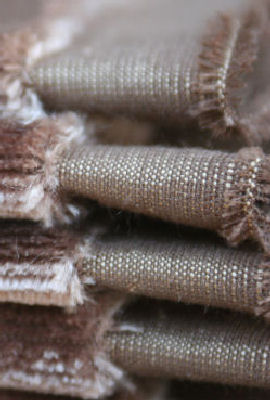Flammability
The measurement of a fabric’s performance when it is exposed to specific sources of ignition.
Note: Association of Contract Textiles (ACT) guidelines specify different flammability tests dictated by the intended end use for the fabric.
Association of Contract Textiles Guidelines
Upholstery
California Technical Bulletin #117 Section E –
Class 1 (Pass)
Direct Glue Wallcoverings
ASTM E 84-03 (Adhered Mounting Method) –
Class A or Class 1
Wrapped Panels and Upholstered Walls
ASTM E 84-03 (Unadhered Mounting Method) –
Class A or Class 1
Drapery
NFPA 701-89 (Small Scale)* – Pass*NFPA 701-99 Test #1 is being phased in at this time, but is not yet cited in all relevant codes. Therefore, the small-scale test remains the ACT standard until further notice.
QuickTime Movies (click links to play)NFPA 701-99 (Small Scale) California TB #117 Section E
TEST METHODS
California Technical Bulletin #117
Section E* – Class 1 (Pass)
The California TB #117 Section E is a test method of the California Bureau of Home Furnishings and Thermal Insulation. It is a vertical flame test measuring the ease of ignition and the burning rate when a small open flame hits the surface of the test fabric for 1 second. A Class 1 (Pass) rating is assigned if:
1. A 5.0″ section of the fabric is consumed in 3.5 or more seconds (less than 3.5 seconds is a failure). For raised surface fabric, the minimum burn time is increased to 4.0 seconds.
2. The fabric does not ignite.
* For complete technical details about California Bulletin #117 Section E: http://www.bhfti.ca.gov/techbulletin/117.pdf
ASTM E 84-03* Tunnel Test
The ASTM E-84 test is a test method of the American Society for Testing and Materials (ASTM). Commonly called the Tunnel Test, this test can be performed under two different methods adhered or non adhered where the only difference is in specimen preparation:
Adhered: The fabric is bonded to either a CA board substitute or gypsum board. This is the prescribed method for wall coverings whose actual use will be adhered .
Non adhered: If the fabric is a panel fabric or upholstered walls, it is tested in a frame without being bonded to any other material.
In each instance (adhered and non adhered), the fabric is placed in the ceiling of the test tunnel and subjected at one end to a high intensity flame which spreads over the first 4.5 feet of the 24 foot test specimen.
The distance of flame front progression and total burning time are used to calculate a flame spread index . Smoke monitors are used to calculate a smoke developed value. The flame spread index and smoke developed value are calculated from the results of the test fabric compared to the characteristics of cement board and red oak materials resulting in the indexes.
Typically, the code classes are as follows:
Class A: Flame Spread Index of 25 or less and Smoke Developed value of 450 or less
Class B: Flame Spread Index of 26 to 75 and Smoke Developed value of 450 or less
Class C: Flame Spread Index of 76 to 200 and Smoke Developed value of 450 or less
Caution: The ASTM E 84 test is only valid if the textile or vinyl wall covering is used in a sprinklered occupancy. If not, the Room Corner Test (NFPA 265 for textiles; and NFPA 286 for vinyl) is mandated in many jurisdictions.
* For complete technical details about ASTM E 84-03: http://www.astm.org
NFPA 701-89 (Small Scale)*
The NFPA 701-89 (Small Scale) is a test method of the National Fire Protection Agency. It measures the ignition resistance of a fabric after it is exposed to a flame for 12 seconds. The flame, char length and flaming residue are recorded. The fabric will pass the test if all samples meet the following criteria (if one sample fails the fabric fails):
1) An after flame of less then 2.0 seconds
2) An average char length of less than 6.5″ or an individual specimen of 7.5″.
3) The specimen does not continue to flame after reaching the floor of the test chamber
Note: NFPA 701-99 Test #1 is being phased in at this time, but is not yet cited in all relevant codes. Therefore, the small-scale test remains the ACT standard until further notice.
* For complete technical details about NFPA 701: http://www.nfpa.org
Revised October 2003:
Source: Association For Contract Textiles
 Mohair Velvet is a type of fabric made from Mohair Wool. It is usually used for upholstery. A velvet is a fabric that is made in a certain way usually ending up with a pile; importantly it can be made from many different fibres including mixtures of fibres.
Mohair Velvet is a type of fabric made from Mohair Wool. It is usually used for upholstery. A velvet is a fabric that is made in a certain way usually ending up with a pile; importantly it can be made from many different fibres including mixtures of fibres.

 Finally! Our summer collections have been decided and we will begin to introduce the new designs and colourways throughout the remainder of this year. We have been inundated with new work in the first part of this year causing our blog posts to be curtailed and our ‘spring’ collection to nearly be an autumn/fall collection. Not that we really do seasonal collections in any case.
Finally! Our summer collections have been decided and we will begin to introduce the new designs and colourways throughout the remainder of this year. We have been inundated with new work in the first part of this year causing our blog posts to be curtailed and our ‘spring’ collection to nearly be an autumn/fall collection. Not that we really do seasonal collections in any case.

